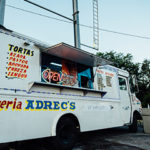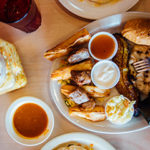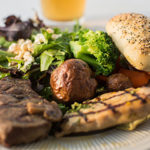What was your last meal on an airplane?
For me, it was two bags of peanuts and one bag of pretzels (plus seltzer) on a Delta flight from Chicago to Laguardia. I felt silly asking for extra snacks, but the flight was half-full and the attendant didn’t bat an eye.
Sometimes when I eat — or hardly eat — on a flight, I remember sweeter airplane meals, usually from years ago. This is partly how I got lost in the worst kind of food porn — passenger snapshots of airline food. They’re not pretty, but they’re addictive in an anthropological kind of way, and they’re all over the Interwebs. It began with this shot from a 2005 American Airlines flight, snapped by flyer Pat Guiney:
And then another on American in a 2010 flight from Paris’ Charles de Gaulle airport to JFK:
Green beans are a common thread here (as are romaine salads and red wine). Asian and Europe-based airlines sometimes serve with a bit more panache. Here’s a shot from Thai Airlines (economy class) in 2007. “Steamed fish, baked potatoes, cauliflower, carrots and peas with a creamy sauce,” wrote passenger Mattes, who snapped the photo:
And this is from KLM in 2010:
The other reason I became immersed in airplane meals is that I was reading about the airport food service workers who protested Thursday in Chicago, Dallas, and elsewhere. They’re urging the three major airlines — United Airlines, Delta Air Lines, and American Airlines — to pay 5 cents more on every ticket sold to the catering subcontractors that load and unload food onto planes. In theory, this “Nickel A Ticket” would enable companies such as Gate Gourmet and LSG Sky Chefs to pay their workers more so that they might afford health insurance. (In Chicago, a Gate Gourmet worker who washes dishes at O’Hare told a Chicago Tribune reporter that she makes $8.71 per hour and cannot pay for heath coverage).
If you want to check out the campaign, you can go here. (And if you want to see more airline meals, visit Wikimedia Commons and search for “in-flight meals”). Both the protests and the shots had me wondering about how the flat wages of U.S. airport catering contract workers relate to the skimpy state of domestic airplane food. On-board $4 hummus-and-chips and $9.99 turkey-and-chutney sandwiches — sometimes the only things available to U.S. economy-class flyers — are being served by workers who, for the most part, earn just above the minimum wage.
Meeting planners have pushed for better food standards at convention centers, and in many cases have made a difference. Whether the public’s muscle can, or should, be applied in the realm of domestic U.S. airplane food (and the labor that supplies it) is worth pondering. The differences between in-flight meals on international and domestic flights, as well as between international and domestic carriers, can be stark.
Here’s an Air Canada economy class meal in 2014, shot by “Shwangtianyuan”:
And an Air China economy meal, 2014:
United Airlines, Shanghai to Guam, January 2015:
United Airlines, Bistro on Board, destination unknown, January 2015:












